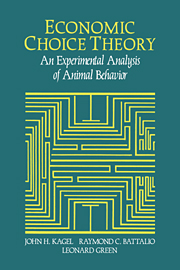Book contents
- Frontmatter
- Contents
- Preface
- Chapter 1 Introduction
- Chapter 2 Commodity-choice behavior I: Some initial tests of the theory
- Chapter 3 Commodity-choice behavior II: Tests of competing motivational processes and the representative consumer hypothesis
- Chapter 4 Labor-supply behavior I: Initial tests of the theory with some public policy implications
- Chapter 5 Labor-supply behavior II: Tests of competing motivational processes and earnings distributions for animal workers
- Chapter 6 Choices over uncertain outcomes
- Chapter 7 Intertemporal choice
- Chapter 8 Summing up
- Bibliography
- Index
Chapter 1 - Introduction
Published online by Cambridge University Press: 22 March 2010
- Frontmatter
- Contents
- Preface
- Chapter 1 Introduction
- Chapter 2 Commodity-choice behavior I: Some initial tests of the theory
- Chapter 3 Commodity-choice behavior II: Tests of competing motivational processes and the representative consumer hypothesis
- Chapter 4 Labor-supply behavior I: Initial tests of the theory with some public policy implications
- Chapter 5 Labor-supply behavior II: Tests of competing motivational processes and earnings distributions for animal workers
- Chapter 6 Choices over uncertain outcomes
- Chapter 7 Intertemporal choice
- Chapter 8 Summing up
- Bibliography
- Index
Summary
Choices of economic agents – consumer-demand and labor-supply behavior, choice under uncertainty – are central to the study of economics and to the performance of economic institutions. In economics, empirical studies of individual choice are usually based on field data collected by government agencies. But such data are of limited value because of the difficulty in obtaining appropriate observations in relation to the theoretical constructs that the theory employs. To overcome this limitation, we embarked on a research program of gathering our own data using experimental laboratory methods. One distinctive feature of this experimental methodology has been the use of nonhuman subjects, primarily rats and pigeons.
Our initial motivation for using rats and pigeons in these experiments was that they provide an economically efficient method of investigating questions about individual choice behavior. The methodology for conducting these experiments was originally developed by experimental psychologists, and we have applied it to questions of interest to economists. We took this step after concluding, on the basis of ample evidence from existing psychological and biological research, that other animals besides humans respond to the basic hedonistic (cost – benefit) calculations underlying economic theory. The fundamental question guiding our initial inquiries was whether the individual choice behavior of these subjects was consistent with more precise implications of economic theory, and if not, what kind of theoretical adaptations would be required to account for the data. As the studies progressed, several major themes emerged.
- Type
- Chapter
- Information
- Economic Choice TheoryAn Experimental Analysis of Animal Behavior, pp. 1 - 7Publisher: Cambridge University PressPrint publication year: 1995



